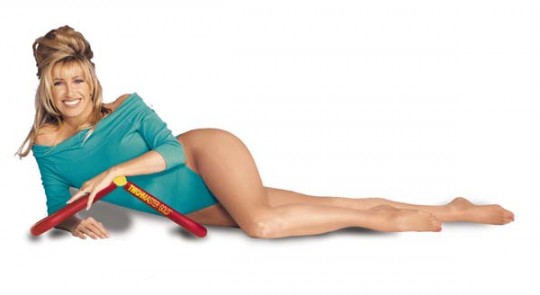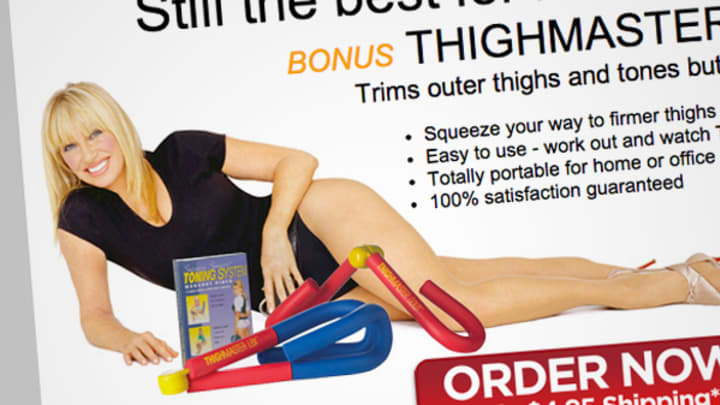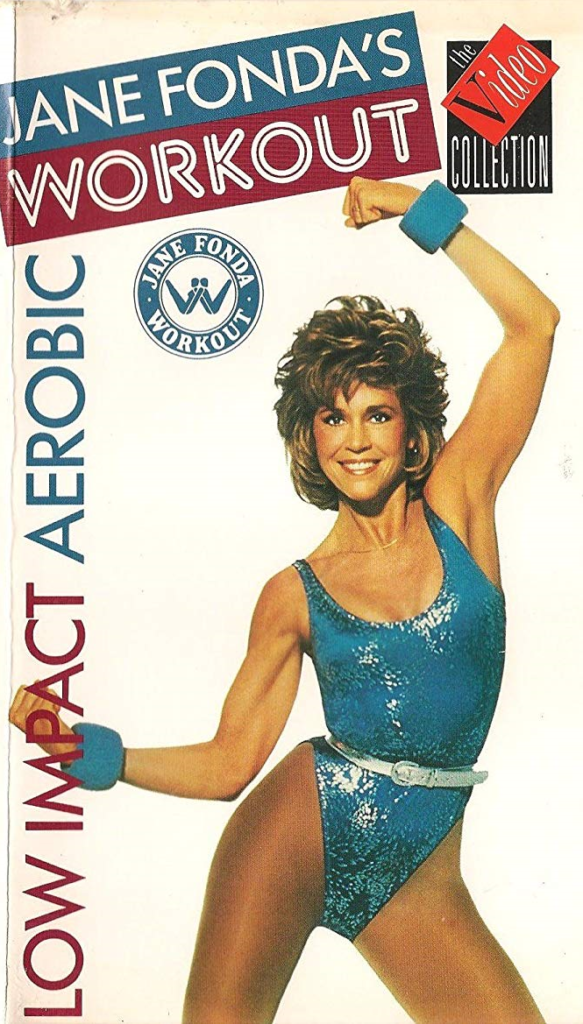
Of all the cult workout products that have dominated the American imagination over the past few decades, the one I least expected to be rooted in feminist protest was the ThighMaster. Consider this TV spot from 1991: “Great legs,” a male voice opines as a pair of disembodied, high-heeled gams stroll onto the screen. “How’d you get ’em?” The legs are revealed to belong to the TV actor Suzanne Somers, who explains to the camera that after doing aerobics “until I dropped,” she finally found an easier way to “squeeze, squeeze your way to shapely hips and thighs.” Male TV hosts mocked the ThighMaster relentlessly (Jay Leno used one to juice an orange on The Tonight Show); consumers—mostly women—bought millions of them anyway, sold on Somers’s cheerful closing pitch: “We may not have been born with great legs, but now we can look like we were.”

The ThighMaster was one of the defining symbols of the ’90s, and yet it might never have burst onto the national stage if not for wage inequality in Hollywood. In 1980, while negotiating her contract for a fifth season of the ABC sitcom Three’s Company, Somers demanded a salary increase that would have brought her pay up to what her co-star John Ritter was making. ABC refused, shrank her role down to infrequent cameos, and then fired her altogether. After a decade spent in the TV wilderness, the ThighMaster was Somers’s ticket to financial autonomy—a home-fitness empire predicated on the troubling idea that women’s bodies could be bought and built, that “problem areas” could be conquered one workout product at a time, that fat could be squeezed, squeezed, into submission.
The ThighMaster exemplifies the paradox the writer Danielle Friedman explores in her fascinating new book, Let’s Get Physical: How Women Discovered Exercise and Reshaped the World. Power and strength, she argues, are not simply figurative entities; they are physical attributes too, and progress for women means having the ability to exercise both. For most of the 20th century, she writes in her introduction, “men enjoyed a lifetime of practicing how to use and trust their bodies; women did not.” Women were corseted and girdled in ways that restricted movement. They were warned of the dire health consequences of running more than two miles at a time, and told that strenuous exercise might impair their reproductive organs and even cause their uterus to fall out. The fight to be able to exercise—to find freedom and release and power in the use of one’s body—is, Friedman explains, tied up inextricably with other battles, as Somers’s own history demonstrates. “When women first started exercising en masse,” Friedman writes, “they were participating in something subversive: the cultivation of physical strength and autonomy.” Who knew where it might lead?

But exercise, for women, also became inextricable from diet culture and beauty culture and everything else built on the truism that the easiest way to get rich is to help a woman feel bad about herself. Early pioneers in the fitness movement quickly realized that their advocacy would seem less threatening if it was feminized—if exercise was touted less as a practice that could make women strong, and more as one that could keep them young and make them beautiful. The sticky marriage of fitness and desirability is one that still needs to be untangled. Friedman writes about discovering barre workouts a few months before her wedding, when a studio near her home promised to transform her “thirty-five-year-old body into that of a ballerina.” That sounded, she thought, “highly probable and completely perfect.” Friedman’s is a common reaction, but why? To harness the true potential of our bodies, we first have to question everything we’ve been taught about them, felt about them, or wanted to change when we looked in the mirror.
This is the time of year when—for the slothlike, the wine-soaked, the people who find oneness and tranquility in the casomorphins of soft cheese (and, to be clear, I am all three of these)—even reading the news can be a fraught activity, rife with briefings on how to actually run a marathon this year, or how a month off alcohol can be revelatory, or why women gain belly fat as they age. To channel my colleague Faith Hill, resolutions are not the vibe for 2022. And yet, reading Let’s Get Physical, I found myself craving the unthinkable: a room filled with other people, a Tina Turner CD, and a really exhausting workout.

Friedman’s book, which persuasively encapsulates the relatively recent history of women’s fitness and the wide-reaching impact its trailblazers had, originated from a story she wrote for The Cut called “The Secret Sexual History of the Barre Workout.” In researching barre, only one of the latest classes to hook women with its promise of sculpted athleticism, she discovered that it was created by Lotte Berk, a “free-love revolutionary,” dancer, and former morphine addict who thought exercise could encourage women to pursue sex for pleasure. Berk’s classes, established in London in 1959, coincided with a moment during which women’s clothing was liberating its wearers and exposing them at the same time. Already, the promise of exercise as a radical tool was being negated by the message that women should change their body to fit a limiting image of beauty.
Let’s Get Physical is defined by characters like Berk: Jane Fonda, Judi Sheppard Missett—who created Jazzercise—and Bonnie Prudden, one of the first women to state plainly, during the 1950s, that all Americans should exercise, regardless of what they were being told by their doctors and the media. (“I’ve observed hundreds of physical education classes around the world,” she was fond of saying, “and I have never seen a uterus on the gym floor.”) Friedman incisively notes the cultural context each woman was working within at the time. Amid the postwar Baby Boom, American identity was shaped by a sense of easy abundance, not collectivist effort. During the Cold War, she writes, the sculpted bodies of Soviet female athletes contributed to a bias against women who dared have any muscle tone at all. And the message for women in particular, after working and striving during the Great Depression and World War II, was that they should relinquish power, “for the sake of the country and the proper social order.”

The idea that women should exercise for their own sake defied the notion that they should be wives and mothers first, people second. It could be popularized only when it was neutered. Prudden, a scrappy descendant of Davy Crockett who channeled her limitless energy into so-called boyish activities such as skiing and mountaineering, was able to persuade women to exercise only when she appealed to their sense of wifely duty. She sold, Friedman writes, “the idea that vigorous physical activity could be a desirable path to beauty, grace, and sex appeal.” It was a formula that stuck throughout the rest of the century.
In subsequent decades, women broke goals and records and rules; still, societal norms reminded them that their bodies existed as objects to be surveyed, not just tested. The first female track athletes to appear on the cover of Sports Illustrated,in 1964, were members of the Texas Track Club—a group, Friedman writes, that was founded to prove “women runners could be fast and feminine,” whose athletes competed in full makeup and with their hair teased in elaborate bouffants. The first-ever all-women road race in America was sponsored by Crazylegs, an S. C. Johnson shaving gel, and featured Playboy Bunnies at the starting line. The progressive evangelism of Jane Fonda’s Workout—that women should seek strength and athleticism for its own sake—became muddled, as Friedman writes, with “a cultural mandate that women strive for physical perfection.” Rather than setting them free, the mainstreaming of exercise added yet another to-do item (pursuit of their best body ever) to women’s lists.

Nevertheless, Friedman is on fitness’s side. After finishing her book and catching up on where her subjects are now (to save time: many of them are in their 80s and 90s, still exercising, and still vital, socially active, and happy), I was too. Let’s Get Physical is clear-eyed about assessing the flaws in the fitness movement—its mixed messaging, its propagation of toxic ideals, its longtime exclusion of differently abled women, plus-size women, and particularly women of color. When Friedman writes about the popularization of running during the 1970s largely among white people, while “Americans of color risked their safety every time they hit the street in sneakers,” it’s impossible not to mourn Ahmaud Arbery, and how far we haven’t come.
But Friedman also understands the different dimensions of power, and how incidentally one kind can lead to another. “As women become more physically competent, they change,” she writes. Let’s Get Physical is packedwith stories of people who come to classes because of how they want to look, but stay because of how those classes make them feel: strong, supported, engaged, and empowered. To lightly adapt some seminal ’70s literature, our bodies are our selves. And the pursuit of fitness—not for aesthetic reasons, but for individual fulfillment and collective strength—is a feminist issue.
If you need dating advice or want to get Lori’s book on meeting and dating athletic women, here is the Amazon Link: How To Meet, Date and Seduce Athletic Women: Meet, Date, Seduce Female Bodybuilders- Fitness Models- Female Wrestlers & Divas, MMS Fighters, Bikini Competitors, Any Athletic Woman!
Article Source: https://www.theatlantic.com/books/archive/2022/01/lets-get-physical-thighmaster-jazzercise-barre/621240/
